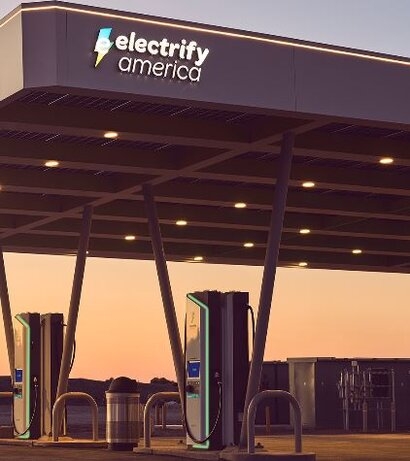
The megawatt-level energy storage system combined with a solar canopy goes a step further than Electrify America’s existing BESS in managing energy costs and reducing stress on the grid by acting as a buffer
to supplement power to charging stations when local utilities limit the amount of power a station can draw from the grid. This application leverages energy storage and solar as a ‘non-wires alternative’ in lieu of relying on additional utility ‘wired’ infrastructure (i.e. power lines) that may not be feasible. Such innovative approaches become critical to expand EV charging into more remote areas to reach more consumers where utilities may not be able to deliver the capacity needed to install or expand charging infrastructure.
“The application of the megawatt-level energy storage is the latest example of how we are continuously innovating to tackle infrastructure challenges and meet charging needs today” said Jigar Shah, Head of Energy Services at Electrify America. “As we expand the use of such solutions to more of our charging stations and also to our medium-duty and heavy-duty electric fleet customers, we are positioned to enable continued transportation electrification even in the face of utility capacity constraints.”
Electrify America selected the Baker station for the first deployment of the megawatt-level energy storage system because of its remote location and its utility capacity constraints. The integration of the
roughly 1.5 MW/3 MWh energy storage system with 66 kW of generation potential from the solar canopy, coupled with sophisticated control technology, is Electrify America’s comprehensive solution for adding additional power to the station.
“To put this into perspective, the energy storage system at Baker, when fully charged, could provide enough energy for an average household for over three months on the single charge” said Mr Shah.
This energy storage deployment builds upon Electrify America’s previous announcement of having surpassed over 30 megawatts of installed energy storage now featured at over 150 locations. In California, over 50 charging stations coupled with energy storage constitute the largest operating Virtual Power Plant (VPP) of its kind shifting the use of on-peak energy to lower carbon intensity off-peak hours in the California Independent System Operator’s wholesale energy market, CAISO.
The expansion at Baker also adds four new individual chargers, bringing the total to twelve. The new chargers feature the latest charger innovations and design. They have some of the fastest charging speeds available today at up to 350 kW (Hyper-Fast), depending on the charger. For example, at 350 kW, capable EVs can recharge up to about 20 miles of driving range per minute of charging. The chargers will also feature the new customer-driven labels to make choosing the right charger speed easier. Customers will also have the ability to pay through the Electrify America App or by credit card.
Customers are already experiencing the benefits of the newly installed energy storage system and charger expansion. Charging load at the site has already surpassed 1 megawatt of peak charging demand, with all of that megawatt-level load at various times being served by just the energy storage system and solar canopy.
The Baker station was also the first to feature other Electrify America innovations like solar canopies, which offer shelter from the elements while helping to store additional renewable energy to help support charging and operations.
In 2021, Electrify America and Electrify Canada networks registered more than 1.45 million customer charging sessions in the US and Canada, respectively, five times the customer charging sessions over 2020, which highlights the growth of our charging network and number of EVs on these roads today. Electrify America plans to roll out additional megawatt-level energy storage systems in the future, including in Long Beach-Wilmington, California as part of the company’s second Green Cities initiative.
For additional information:

